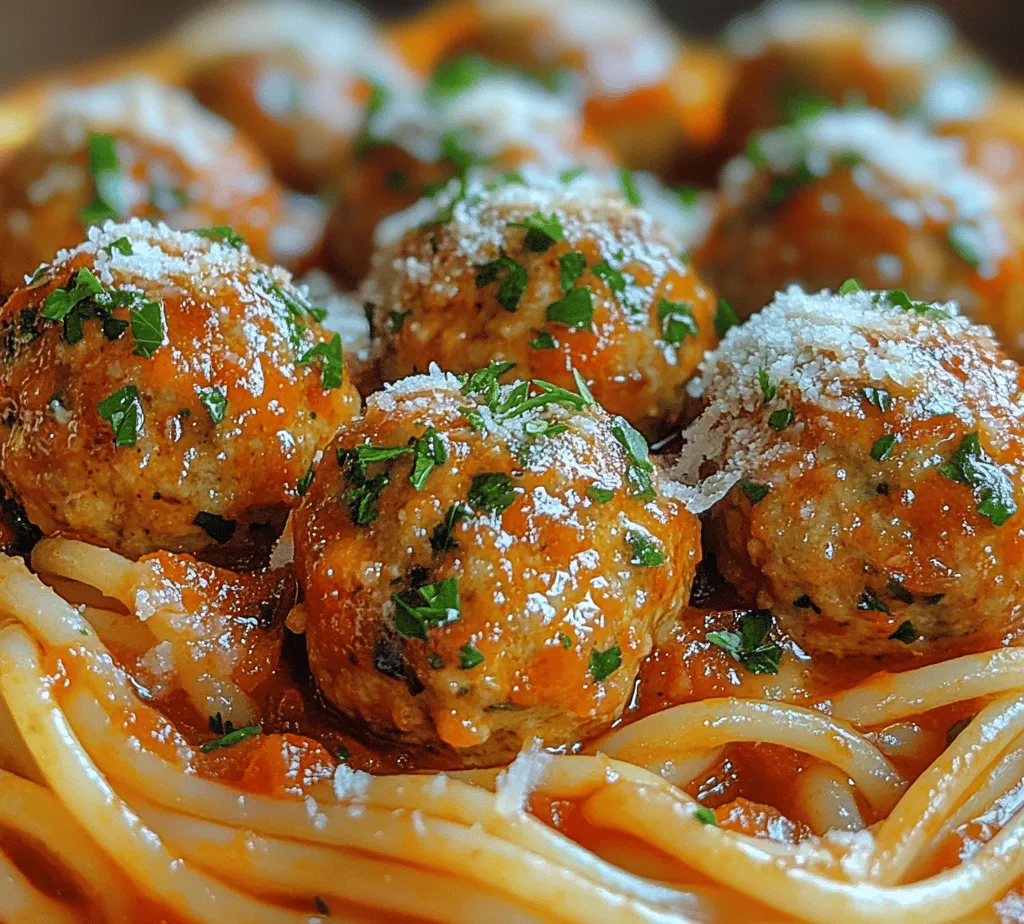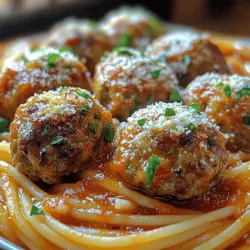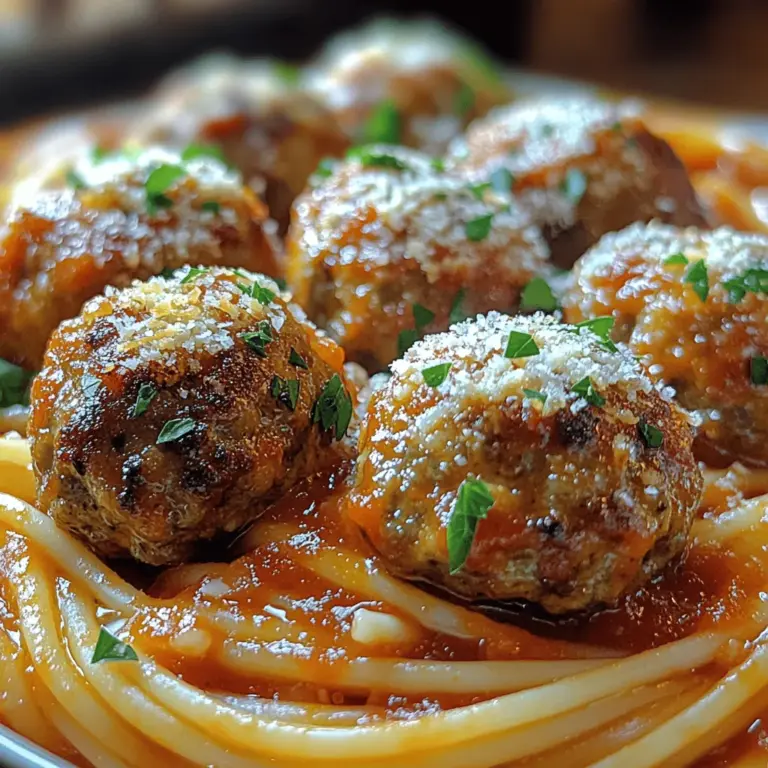Introduction
There’s something undeniably comforting about a plate of Italian meatballs. This classic dish has captured the hearts and palates of food lovers around the globe, thanks to its rich flavors and heartwarming aromas. Italian meatballs are not just a meal; they embody tradition, family gatherings, and culinary artistry. Whether served as a main dish paired with spaghetti, as an appetizer at a gathering, or even as a delightful addition to a sandwich, savory Italian meatball delights have earned their place in the pantheon of favorite comfort foods.
The beauty of Italian meatballs lies in their versatility. They can be enjoyed in various forms, from traditional recipes to modern twists. When prepared with fresh ingredients and time-honored techniques, these meatballs become a symphony of flavor, drawing everyone to the table. The combination of ingredients, ranging from ground meats to herbs and spices, creates a dish that is both hearty and satisfying. In this article, we will explore the essential components of savory Italian meatballs, delve into the preparation steps, and share tips to ensure your meatball experience is unforgettable.
Understanding the Ingredients
To create savory Italian meatball delights, it’s crucial to understand the key ingredients that contribute to their distinct flavor and texture. Each component plays a vital role, and the right choices can elevate your meatballs from good to exceptional.
Ground Meat Choices
One of the foundational elements of any meatball recipe is the choice of ground meat. Traditional Italian meatballs often feature a combination of ground beef and ground pork. This mix provides a balanced flavor and added moisture, resulting in tender meatballs that are not dry. Ground beef offers rich flavor and a satisfying bite, while ground pork introduces a subtle sweetness and fat content that keeps the meatballs juicy.
For those who prefer a lighter option, ground turkey or chicken can be used. However, it’s essential to adjust the seasoning and perhaps add a bit more fat, such as olive oil, to ensure the meatballs remain moist. Regardless of your choice, selecting high-quality meat from a reputable source will enhance the overall flavor of your dish.
Breadcrumbs
Breadcrumbs are often an underrated ingredient in meatball recipes, yet they are pivotal for achieving the perfect texture. Italian-seasoned breadcrumbs are preferred due to their blend of herbs and spices, which infuse the meatballs with additional flavor. These breadcrumbs act as a binding agent, absorbing moisture and helping to maintain the meatballs’ structure during cooking.
When using breadcrumbs, consider the texture as well. Fresh breadcrumbs made from day-old Italian or French bread work beautifully, providing a light and airy texture. Alternatively, store-bought Italian breadcrumbs are convenient and effective, ensuring that your meatballs are both flavorful and cohesive.
Cheese and Herbs
Adding freshly grated Parmesan cheese and herbs like parsley can significantly elevate the taste of your meatballs. Parmesan not only contributes a nutty, salty flavor but also adds a bit of creaminess that enhances the overall mouthfeel. Fresh parsley brings brightness to the dish, balancing the richness of the meat and cheese.
For those who enjoy a bit of extra flavor, consider adding other fresh herbs such as basil or oregano. These herbs are staples in Italian cooking and will deepen the flavor profile of your meatballs, making them even more delightful.
Spices and Seasoning
The spices you choose can make or break your meatballs. Classic ingredients such as minced garlic, dried oregano, salt, black pepper, and red pepper flakes are essential for flavoring. Garlic offers a pungent aroma and depth, while oregano imparts that signature Italian flavor. Salt and black pepper are fundamental for seasoning, helping to enhance the natural flavors of the meat and other ingredients.
Red pepper flakes can be added for those who enjoy a bit of heat. The amount can be adjusted based on personal preference, allowing you to customize the spice level of your meatballs to suit your taste.
Marinara Sauce
No Italian meatball dish is complete without a quality marinara sauce. The sauce not only complements the meatballs but also adds moisture and richness to the overall dish. When selecting marinara sauce, opt for one made from high-quality tomatoes, olive oil, and fresh herbs. A homemade sauce can be a delightful addition, allowing you to control the ingredients and tailor the flavor to your liking.
Using a good marinara sauce can significantly elevate your meatball dish, whether it’s poured over spaghetti, served as a dip, or used to enhance the meatballs in a sub sandwich.
Preparation Steps for Savory Meatballs
Now that we have a solid understanding of the ingredients, let’s delve into the preparation steps for creating savory Italian meatballs. Following these detailed instructions will ensure that your meatballs are flavorful, tender, and a hit with everyone who tries them.
Preheating the Oven
Before you begin mixing your ingredients, it’s essential to preheat your oven to 400°F (200°C). Preheating guarantees that your meatballs will cook evenly and achieve a beautiful golden-brown color. While the oven is heating, prepare a baking sheet lined with parchment paper or lightly greased to prevent sticking. This step will make clean-up easier and help the meatballs cook uniformly.
Mixing Ingredients
The mixing process is where the magic happens. In a large mixing bowl, combine your ground meat, breadcrumbs, grated Parmesan cheese, minced garlic, chopped parsley, oregano, salt, black pepper, and red pepper flakes. Use your hands to mix the ingredients gently, being careful not to overwork the meat. Overmixing can lead to tough meatballs, so aim for just enough mixing to incorporate all ingredients thoroughly.
If you choose to include additional ingredients, such as chopped onion or bell pepper, make sure they are finely diced to ensure even distribution throughout the meat mixture.
Shaping the Meatballs
Once your ingredients are well combined, it’s time to shape the meatballs. Use a cookie scoop or your hands to portion out the mixture. For uniform cooking, aim for meatballs that are about 1 to 1.5 inches in diameter. This size is ideal as it allows for even cooking and ensures that they remain tender on the inside.
As you shape each meatball, gently roll them between your palms to create a smooth surface. This technique helps prevent cracks during baking and gives your meatballs an appealing appearance.
Browning the Meatballs
Browning the meatballs before baking is a crucial step in enhancing their flavor. In a large skillet, heat a drizzle of olive oil over medium-high heat. Once the oil is hot, add the meatballs in batches, making sure not to overcrowd the pan. Brown the meatballs on all sides for about 3-4 minutes until they develop a rich, golden crust.
This browning process not only adds depth of flavor but also seals in the juices, ensuring your meatballs remain moist during baking. After browning, transfer the meatballs to the prepared baking sheet, where they will finish cooking in the oven.
Baking the Meatballs
After browning, it’s time to bake the meatballs, a method that offers numerous advantages, including better texture and ease of cooking. Baking allows for a more hands-off approach, freeing you up to prepare other components of your meal.
Optimal Baking Temperature
With your oven preheated to 400°F (200°C), place the baking sheet with the browned meatballs into the oven. Bake for about 15-20 minutes, or until the meatballs are cooked through and reach an internal temperature of 160°F (70°C). This temperature ensures that the meat is safe to eat while remaining juicy and flavorful.
Checking for Doneness
To check for doneness, use an instant-read meat thermometer. Insert the thermometer into the center of a meatball, ensuring it does not touch the baking sheet. Once the meatballs reach the safe internal temperature, they are ready to be removed from the oven. If you prefer to skip the thermometer, you can cut one meatball in half to check that the center is no longer pink and that the juices run clear.
By following these detailed preparation steps, you’ll be well on your way to creating savory Italian meatball delights that will impress your family and friends alike. The combination of fresh ingredients, traditional techniques, and careful attention to detail will ensure that every bite is a flavorful experience, making these meatballs a cherished addition to your culinary repertoire.

Creating the Marinara Sauce
As your savory Italian meatballs bake to perfection, it’s essential to prepare a delicious marinara sauce that complements their rich flavors. Marinara sauce is a classic Italian staple that elevates any meat dish, enhancing its taste and creating a well-rounded meal.
Choosing Marinara Sauce
When it comes to marinara sauce, you have two primary options: store-bought and homemade. Store-bought sauces can be a time-saver, especially on busy weeknights. Look for brands that use high-quality ingredients without unnecessary preservatives. Popular choices include Rao’s, Prego, and Classico, known for their robust flavors and consistent quality.
However, if you have the time, making homemade marinara sauce is a rewarding endeavor that allows you to control the ingredients and customize the flavor profile. To make a simple marinara at home, sauté garlic and onions in olive oil, add crushed tomatoes, and season with fresh basil, oregano, salt, and pepper. Allow it to simmer for at least 30 minutes to develop a deep flavor.
Heating Techniques
Regardless of whether you opt for store-bought or homemade, heating the marinara sauce properly is crucial. Start by transferring the sauce into a saucepan and place it over medium heat. Stir occasionally to ensure it heats evenly and doesn’t stick to the bottom of the pan. If using a store-bought sauce, consider adding a splash of red wine or a pinch of sugar to enhance the flavors. If you prepare homemade sauce, taste and adjust the seasoning as needed.
To avoid burning, pay close attention to the heat. You want the sauce to reach a gentle simmer rather than a full boil. If the sauce begins to bubble too vigorously, reduce the heat. For an even more luxurious texture, you can add a splash of cream or a knob of butter at the end of the cooking process, which will enrich the sauce and add a hint of richness.
Serving Suggestions
The beauty of savory Italian meatball delights lies in their versatility. Here are various ways to serve them, ensuring that each presentation showcases the mouthwatering flavors of this beloved dish:
Over Pasta: One of the most classic ways to serve meatballs is over a bed of pasta. Spaghetti is the traditional choice, but you can also use penne, rigatoni, or any pasta shape you prefer. Cook the pasta until al dente, drain it, and toss it with a bit of olive oil, salt, and pepper before layering the meatballs on top. Generously spoon the marinara sauce over the meatballs and finish with freshly grated Parmesan cheese and a sprinkle of chopped parsley for a vibrant touch.
Meatball Sandwiches: For a hearty meal, consider serving the meatballs in a sandwich. Take a fresh sub roll or a hoagie, toast it lightly, and fill it with meatballs and marinara sauce. Top with provolone or mozzarella cheese, then place it under the broiler until the cheese is bubbly and golden. This option is perfect for lunch or a casual dinner, offering a delightful handheld meal that’s both satisfying and flavorful.
Standalone Appetizer: If you’re hosting a gathering, meatballs can serve as an excellent appetizer. Arrange the meatballs on a platter and drizzle with marinara sauce. Garnish with extra grated Parmesan and fresh parsley for an appealing presentation. Provide toothpicks for easy serving, allowing guests to enjoy these delicious bites without the need for utensils.
Nutritional Information
Understanding the nutritional benefits of your ingredients can help you make informed decisions while enjoying your savory Italian meatball delights.
Protein Content: One of the standout features of meatballs is their protein content. Ground beef or pork provides a rich source of protein, essential for muscle repair and overall health. Additionally, if you choose to incorporate cheese into your meatball mixture, you’ll boost the protein content even further.
Vitamins and Minerals: Fresh herbs like parsley and basil not only enhance flavor but also add nutritional benefits. Parsley is rich in vitamins A, C, and K, while garlic offers antimicrobial properties and various vitamins and minerals. Incorporating these ingredients into your meal increases its overall nutritional profile, making it not just delicious but also healthful.
Caloric Considerations: While meatballs can be a hearty option, portion sizes matter. A typical serving of meatballs (about three meatballs) can range from 300 to 500 calories, depending on the ingredients used. Pairing the meatballs with a generous serving of vegetables or a salad can help balance the meal, ensuring you enjoy all the flavors without overindulging.
Cultural Significance of Italian Meatballs
Italian meatballs are steeped in history and cultural relevance, reflecting the rich tapestry of Italian cuisine.
Regional Variations: Across Italy, meatballs vary significantly in style and preparation. In Southern Italy, you’ll often find larger meatballs served with rich tomato sauce, while Northern Italy may favor smaller, more delicate variations typically served without sauce. Each region has its unique twist, influenced by local ingredients and traditions.
Meatballs in Italian-American Cuisine: Italian immigrants brought their culinary traditions to America, where meatballs evolved further. Here, they became a staple in Italian-American cuisine, characterized by larger sizes and the incorporation of ingredients like breadcrumbs and eggs to bind the mixture. The classic spaghetti and meatballs dish emerged as a beloved comfort food, representing the fusion of Italian heritage and American culture.
Conclusion
Making and sharing savory Italian meatball delights is more than just a culinary experience; it’s a celebration of flavor, tradition, and togetherness. The process of crafting these meatballs, from mixing the ingredients to pairing them with a rich marinara sauce, brings families and friends together around the dinner table.
Encourage your loved ones to join in the cooking process, transforming it into a communal activity that fosters connections through food. As you savor each bite, remember the rich history behind this dish and the joy it brings to your home. Embrace this recipe as a staple in your culinary repertoire, allowing the vibrant flavors of Italy to inspire your kitchen creations. Enjoy the warmth and satisfaction that a homemade meal can provide, and share the love through every delicious meatball.

